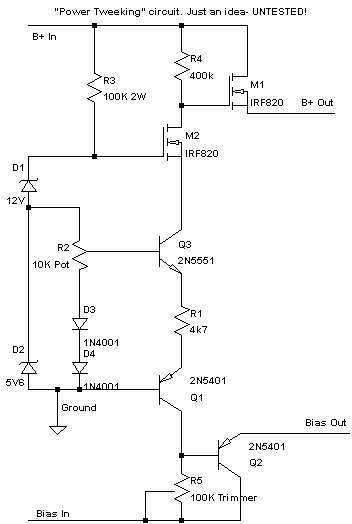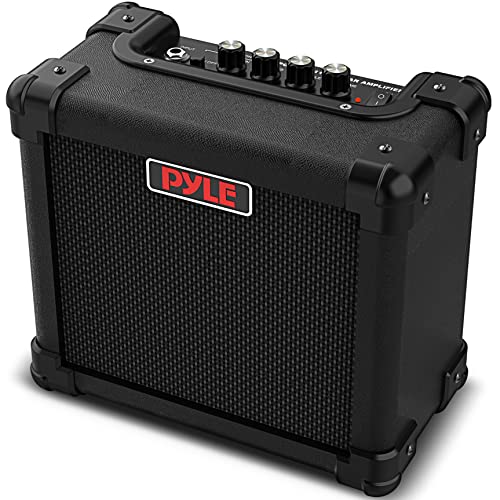YellowJacket
Well-known member
Can we preserve the recto roar without fizzies? Are the fizzies merely a biproduct of not running the amp hot enough?
I saw some internet literature on power scaling and I thought it was worth a discussion at least. Of course, it isn't terribly applicable to Master Volume High Gain heads where most of the tone is shaped in the pre-amp section of the amp. At best, it would be a more efficient and customizable version of a multiwatt amp. At worst, it would be just another component to break. While it may ore may not be feasible, I think it is a terribly interesting idea worth at least looking into.
In a nutshell, power scaling allows a player to adjust the 'maximum power output' of an amplifier via an extra knob. With the model I looked at, the output power can theoretically be adjusted from 100watts down to 0.01watts. The idea is that you can put your amp in the 'sweet spot' of tube saturation and turn down the 'volume' of your amp instead of the 'tone'. Great idea in theory.
As many people on a forum (Listed below) pointed out, some potential considerations are:
1) Speaker Response: Basically, you need sufficient power going through the speakers to get a certain tone. If you like the sound of speakers working and moving air, power scaling won't help you with that.
2) As you turn the wattage down, you'll end up with a 'small amp cranked' sound where you loose the power and thump you get with a 100watt high gain head, even at lower volumes. For example, when you adjust the variac switch on a Recto, it affects the tone and 'feel' of the amp. On Spongy--which is a lower wattage setting--the tight and thumpy gain tone becomes much more squishy, elastic, and anemic. Now, I noticed that Spongy can give tube growl at lower volumes but this is at the expense of raw power and a HUGE tone. Bold just sounds so much more phat and aggressive. Why would a guitarist need yet another button that tears the testicles off of his amplifier?
3) Fletcher-Munson Curve: As everyone here knows, loud music sounds different than quiet music because of how we perceive sound. As we turn our gear up louder, we will hear more bass and treble as well as less mids. Does this means that a power scaling kit is making a promise it is simply impossible to deliver.
4)On the plus side, people "CLAIM" that these things sound better than power attenuators while simultaneously being far more effective. I'd have to hear one for myself . . .
I don't know about others here but I am personally interested in any sort of good tone / ultra low volume solution because I have been in utterly paralyzing situations that require that sort of a drastic solution. I personally do not like having my amp turned down so far that the cleans are sterile and the gain is almost as fizzy and grainy as a solid state amp. I paid $$$$$$s for it, and it should sound that way. Just to have tube crunch is all I really NEED for what I mostly do with guitar, so it doesn't matter if it sounds thunderous and thumpy or not, as long as it crunches. Maybe I should just concentrate on playing instead?
Here are a few links I checked out.
From an amp builder.
http://www.londonpower.com/pscaling.htm
Of course forumites know EVERYTHING ALWAYS. **hurrhurr**
http://music-electronics-forum.com/t2996-2/

Of course I know nothing about amp building and electronics beyond how to work out impedance and how to wire a speaker cab / how to change tubes, but I think the idea is interesting.
Devils Advocate: Another point to consider - Why have I not seen any attempts to make a much less efficient guitar speaker? Would this work far better than an attenuator? I know nothing about the physics of guitar loudspeaker manufacture and I do not know if the specific (pleasing) distortion characteristics of guitar speakers can be preserved while drastically reducing the sensitivity. I just find it odd that there I don't see a record of this being attempted. Perhaps I have not looked hard enough. Basically, a 4 x 12 with 4 12" speakers putting out 86db/watt/metre would be almost as effective as running an attenuator on a fairly high setting. In this case, the inefficiency of the speaker would instead be sucking power. I can speculate that a floppy speaker cone a la greenback in a low efficiency speaker may work to replicate 'more' of a cranked tone at low volumes, especially when operating in tandem with a low power amp. The only potential problem is that perhaps the physical behavior of a guitar speaker is contingent on its high sensitivity and therefor, in this scenario, the task of engineering a guitar loudspeaker without this property would be an impossible task. Only way to find out would be to talk to a speaker builder.
As an aside: I consider that I had a valvestate minimarshall cab back in the day and the 35watt 93db/watt/metre sounded eerily similar to G12T-75s but warmer and with more cone breakup. I don't recall that they were all that quieter. I also notice that cheap computer speakers distort at surprisingly low volumes. Perhaps I am on to something here?
I saw some internet literature on power scaling and I thought it was worth a discussion at least. Of course, it isn't terribly applicable to Master Volume High Gain heads where most of the tone is shaped in the pre-amp section of the amp. At best, it would be a more efficient and customizable version of a multiwatt amp. At worst, it would be just another component to break. While it may ore may not be feasible, I think it is a terribly interesting idea worth at least looking into.
In a nutshell, power scaling allows a player to adjust the 'maximum power output' of an amplifier via an extra knob. With the model I looked at, the output power can theoretically be adjusted from 100watts down to 0.01watts. The idea is that you can put your amp in the 'sweet spot' of tube saturation and turn down the 'volume' of your amp instead of the 'tone'. Great idea in theory.
As many people on a forum (Listed below) pointed out, some potential considerations are:
1) Speaker Response: Basically, you need sufficient power going through the speakers to get a certain tone. If you like the sound of speakers working and moving air, power scaling won't help you with that.
2) As you turn the wattage down, you'll end up with a 'small amp cranked' sound where you loose the power and thump you get with a 100watt high gain head, even at lower volumes. For example, when you adjust the variac switch on a Recto, it affects the tone and 'feel' of the amp. On Spongy--which is a lower wattage setting--the tight and thumpy gain tone becomes much more squishy, elastic, and anemic. Now, I noticed that Spongy can give tube growl at lower volumes but this is at the expense of raw power and a HUGE tone. Bold just sounds so much more phat and aggressive. Why would a guitarist need yet another button that tears the testicles off of his amplifier?
3) Fletcher-Munson Curve: As everyone here knows, loud music sounds different than quiet music because of how we perceive sound. As we turn our gear up louder, we will hear more bass and treble as well as less mids. Does this means that a power scaling kit is making a promise it is simply impossible to deliver.
4)On the plus side, people "CLAIM" that these things sound better than power attenuators while simultaneously being far more effective. I'd have to hear one for myself . . .
I don't know about others here but I am personally interested in any sort of good tone / ultra low volume solution because I have been in utterly paralyzing situations that require that sort of a drastic solution. I personally do not like having my amp turned down so far that the cleans are sterile and the gain is almost as fizzy and grainy as a solid state amp. I paid $$$$$$s for it, and it should sound that way. Just to have tube crunch is all I really NEED for what I mostly do with guitar, so it doesn't matter if it sounds thunderous and thumpy or not, as long as it crunches. Maybe I should just concentrate on playing instead?
Here are a few links I checked out.
From an amp builder.
http://www.londonpower.com/pscaling.htm
Of course forumites know EVERYTHING ALWAYS. **hurrhurr**
http://music-electronics-forum.com/t2996-2/

Of course I know nothing about amp building and electronics beyond how to work out impedance and how to wire a speaker cab / how to change tubes, but I think the idea is interesting.
Devils Advocate: Another point to consider - Why have I not seen any attempts to make a much less efficient guitar speaker? Would this work far better than an attenuator? I know nothing about the physics of guitar loudspeaker manufacture and I do not know if the specific (pleasing) distortion characteristics of guitar speakers can be preserved while drastically reducing the sensitivity. I just find it odd that there I don't see a record of this being attempted. Perhaps I have not looked hard enough. Basically, a 4 x 12 with 4 12" speakers putting out 86db/watt/metre would be almost as effective as running an attenuator on a fairly high setting. In this case, the inefficiency of the speaker would instead be sucking power. I can speculate that a floppy speaker cone a la greenback in a low efficiency speaker may work to replicate 'more' of a cranked tone at low volumes, especially when operating in tandem with a low power amp. The only potential problem is that perhaps the physical behavior of a guitar speaker is contingent on its high sensitivity and therefor, in this scenario, the task of engineering a guitar loudspeaker without this property would be an impossible task. Only way to find out would be to talk to a speaker builder.
As an aside: I consider that I had a valvestate minimarshall cab back in the day and the 35watt 93db/watt/metre sounded eerily similar to G12T-75s but warmer and with more cone breakup. I don't recall that they were all that quieter. I also notice that cheap computer speakers distort at surprisingly low volumes. Perhaps I am on to something here?






















